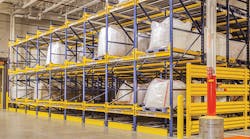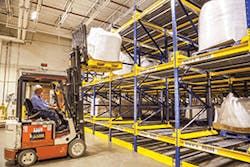While warehouses, distribution centers and other storage facilities can increase profits with pallet flow's high-density, labor-saving storage capacity—which can store up to 100% more product than selective rack and reduce aisle space by 75%—managers will want to maximize its benefits while avoiding common errors in its design and installation.
To optimize pallet flow, more planning and precision is required than with traditional storage. With pallet flow, dynamic flow rails are inclined in a static rack structure, allowing loads placed on one end to move by gravity on rollers to the unloading end, with speed controllers acting as gentle brakes.
When pallet flow is designed and installed correctly, as each pallet load is removed, the pallets behind it move forward automatically. Once loaded, first-in first-out (FIFO) product rotation is automatic. Forklifts are only required for the initial loading and final unloading because the rack eliminates the labor and forklift operation required to arrange loads in traditional racking.
Pallet Flow Design Tips
1) Use consistent, quality pallets of specified design.While pallets are designed to fully rest on a floor, with pallet flow the pallet mimics the floor in an elevated flow lane. The pallet is put on rollers or wheels and gravity takes it from point A to B, so it's critical to understand the pallet's bottom.
It is not enough to tell the pallet flow manufacturer you have a Grocery Manufacturers Association (GMA) pallet because that has become a loosely-used term. When GMA first came out, it was defined as a 40" x 48" five-bottom board pallet, but today there are hundreds of pallet types in the market, including wood, plastic, skids, metal containers, and shipping racks of various dimensions and configurations.
Not considering the bottom of the pallet can lead to a flow system that uses rollers when wheels are required or vice versa, or the brakes can be improperly specified causing pallet hang-ups or damaged brakes.
Which direction are the bottom boards going, and how wide and thick are they?
When gathering info for your pallet flow quote, take pictures of all your pallet types and provide their dimensions and configurations. Plan for any future pallet types that may be required for new products or logistics as well.
2) What do you need to design around?To maximize pallet flow storage capacity, work with your pallet flow dealer to provide all of the pertinent dimensions and limitations of your facility, including the limits of the forklifts to be used with it.
What are your ceiling height, building width, depth, floor footprint, and floor slab weight capacity? Are there any obstructions like doors, lights, vents, sprinklers, or building columns that must be planned for or built around? In terms of equipment, how high can your forklifts lift, and what loads can they carry and place?
When requesting a quote, you should ask for a conceptual drawing from your pallet flow vendor. A conceptual drawing should show what the pallet flow storage will look like from the front and side elevations. Having that visual can help you coordinate work with sprinkler installers and expedite permitting from city hall and the fire marshal.
To ensure the pallet flow design is up to code, the warehouse's zip code should be checked to satisfy seismic standards for the area. The design should meet specifications from the Rack Manufacturers Institute (RMI), the American Iron and Steel Institute (AISI) and American Institute of Steel Construction (AISC).
3) Strategically plan pallet flow for efficient storage, loading/unloading, and transport.Let gravity do the work with pallet flow by designing pallet unloading as close to the truck loading dock as feasible.
With pallet flow, forklift travel distance can be minimized with proper planning. You don't have to travel 200' down an aisle to pick a pallet out of selective or drive in rack. You can simply travel just 20' down, pick a pallet, load a truck, and when you return, the next pallet is waiting in the same place so loading and unloading is faster.
The same strategic planning applies to pallet flow storage depth, which should be designed and grouped to logistically ease loading and unloading. Just because you can design pallet flow storage 20 pallets deep doesn't mean you should. Consider what works best. If you can only load 10 pallets at a time in a truck, it may be better to design the system 10 pallets deep but several levels high. After unloading one group of 10 pallets, go to the level above to unload the next truckload of pallets.
Pallet Flow Installation Tips
4) Meet critical tolerances for good gravity flow results.Because pallet flow storage requires precision to work properly, it must be installed by fully trained and qualified installers.
It is important to specify installation tolerances during the project development stage, and then make sure to include them in the installation documentation and the labor contract. When the rack installation is complete, review these tolerances at installation start-up, and check them one final time before system sign off. Using a transit or laser level achieves better results.
Some of the critical tolerances my company requires for pallet flow success include:
Rack must be leveled, shimmed and securely anchored to ensure that all flow support beams are level and their elevations do not deviate from a true pitch line by more than ±1/16".
Rail must be installed at the specified slope and must not deviate from a true pitch line by more than 1/16".
The slope of the tracks must be consistent throughout the length of the lane to within ±0.1% of the design slope.
Wheel flow and full width roller Installation requires maximum allowable pallet deflection of 1/8".
Because of the precision involved, it's strongly advised that one lane be installed and tested for pallet flow prior to installing the remaining lanes. Following that first bay test, ongoing testing is recommended to assure correct installation.
As bays within a system are completed, the installer should test each lane for proper flow if space allows. The "test-as-you go" method allows the crew to depart shortly after the completion and testing of the final bay. This improves crew scheduling, and reduces or eliminates the need for return "adjustment" trips.
Due to the required precision of pallet flow storage, its rails should be protected from forklift impact, which can knock rails out of alignment and damage components. One common way to protect pallet flow rails is to design, manufacture and install the load-end and unload-end beams so the rail is hidden behind the beam and cannot be directly impacted by the forks.
5) Coordinate vendors and installation.Since designing and installing pallet flow storage may involve a pallet flow manufacturer, a rack manufacturer, as well as a dealer and an installer, it is beneficial to work with an OEM with turnkey pallet flow and rack capability and a national dealer network.
If a system isn't working properly, getting several vendors together to troubleshoot can be frustrating, particularly if no one takes final responsibility. It's much easier to work with a manufacturer who can plan for and coordinate the entire process up front.
Ryan Wachsmuth is dynamic storage sales manager at Steel King Industries, a designer and manufacturer of warehouse material handling, storage and safety products. Del Williams, a technical writer based in Torrance, Calif., contributed to this article.




